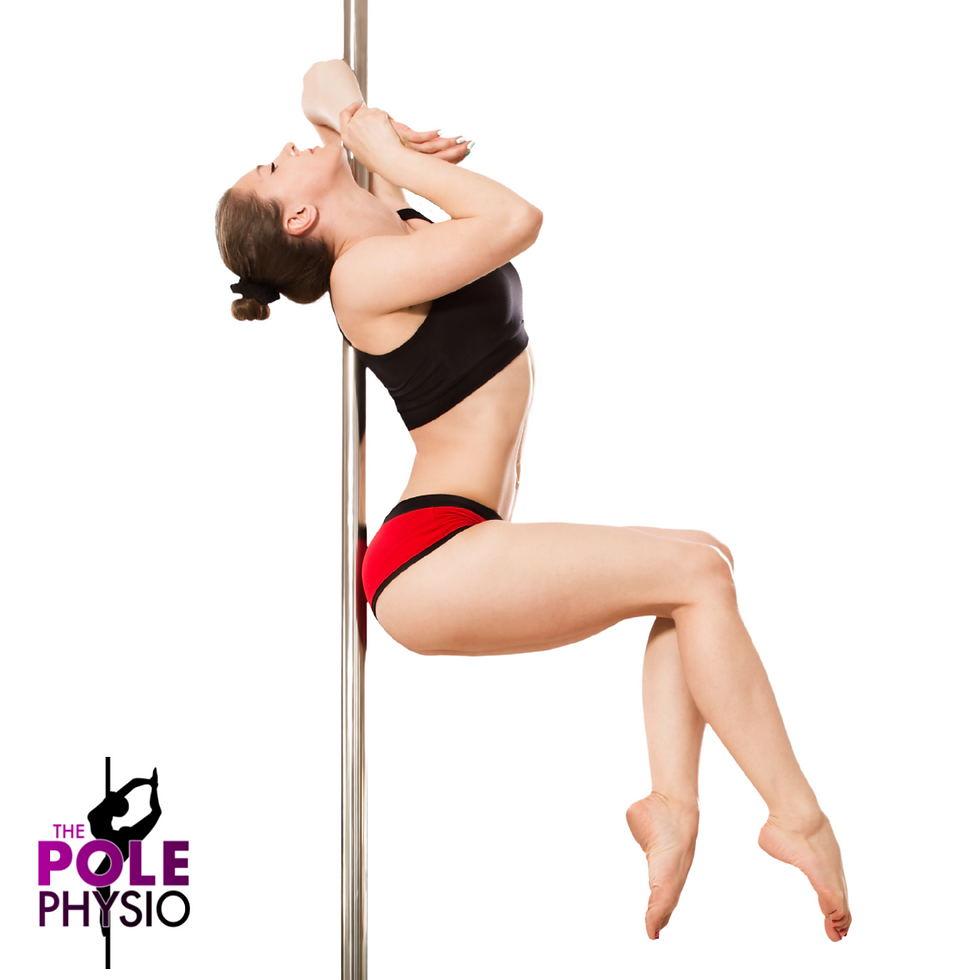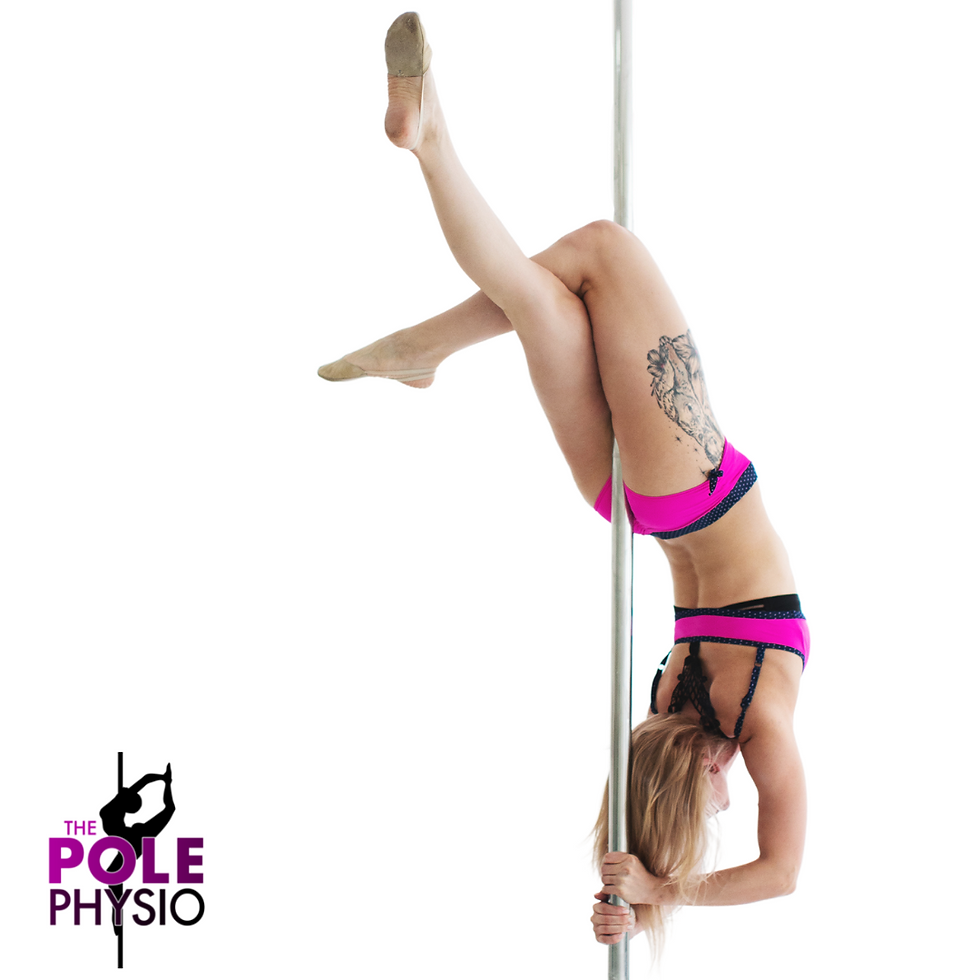Are you working on your split grip and finding your shoulder is pinching? Or trying to nail your chair spin and noticing a pulling feeling in the back of your arm? Have you been challenging your shoulder conditioning off the pole but still can’t achieve comfortable movement above your head?
It is automatic to think your shoulder is the problem, after all that is where it hurts! We have gone into great detail in the past on specific injuries of the shoulder that are common in pole dancing. These include subacromial impingement syndrome and rotator cuff pathology.
However, at times it’s important to know that your middle back may be the culprit. This area is otherwise known as the thoracic spine.
What is your thoracic spine?

Let’s get a bit 'physio' here for a moment.
The thoracic spine is the middle section of your spine. It is made up of 12 vertebrae that links your cervical spine (neck) and lumbar spine (lower back) together. Our ribs connect to the sides of the thoracic spine and our positioned in semicircle style, connecting to the breastbone at the front of your chest. This is what forms our ribcage.
As you may have already realised, the upper back is the only part of our spine that has a ribcage and it’s certainly not by chance that we were designed this way. Our ribcage has the incredibly important role of protecting the organs in the chest; our heart and lungs are vital for survival so it’s only fitting that they are protected by a sturdy cage.

In addition, the ribcage provides attachments for the diaphragm to help us breathe. When we hold our breath, this increases the rigidity around the rib cage, creating a false sense of increased strength and control. Reminds me of the first time I did an invert – I definitely did not breathe like I was supposed to!
There are a number of muscles that attach around the thoracic spine, including the muscles that help keep the shoulder blade moving correctly like the rhomboids and trapezius, as well as some of the larger muscles we use (our lats!).
Is our back stiff or is it normal??
Ever found yourself wondering: ‘Why is my upper back so damn stiff?!'
I find myself being asked this question almost on the daily by my patients in clinic! Whilst the thoracic spine can feel stiff, it is actually an incredibly stable structure that's designed to move!
Come again you say?
Yes - our upper back is designed to move! But the orientation of our facet joints in the upper back means it moves differently to our neck or lower back. This was covered in great detail in our backbending blogs, but as a quick recap here it's important to know our upper back can extend and flex, but it actually prefers rotational movements. Whereas the lower back prefers the opposite.
So it's definitely harder to move the thoracic spine in a way that it's not designed to (extension) and sometimes polers think that this means their back is stiff! When in reality we are just limited by our upper back's normal range of motion and strength.
BUT in our line of work we do tend to see a lot of polers with a stiff generally thoracic spine. Whether that be with their rotation or extension movements. And if the thoracic spine is STIFF, then movement in all directions is going to be much harder than usual! Have you ever tried to shoulder mount with a rigid spine? It ain't pretty!
So to recap, there can be a natural limitation of movement that we sometimes mistake as stiffness, we can also have actual 'mechanical' stiffness of our backs that we will discuss in greater detail later in this blog, but there's also a third type of stiffness that we see in pole. Let's talk about this now. This is the creation of stiffness during breathing to assist us when on the pole.
Do you find yourself occasionally not breathing when poling (tricks)?

Well this is something that we at The Pole Physio have termed creating a sense of 'dynamic rigidity'. We alluded to it earlier when we talked about holding our breath during our first ever straddle. And it basically is the sense of trying to create active stiffness through the ribcage and abdominals whilst exercising by altering our breathing mechanics.
Other athletes such as weightlifters do this all the time. And it's thought to be quite helpful by increasing abdominal pressure, force/power production, speed of movement, by creating a sense of security and increasing efficiency of the movement. This is why you may not see weightlifters breathe during certain points of a heavy lift and why they use tools like belts to help them out. It's definitely a helpful strategy for them!
So you're probably now wondering if this is different for pole dancers?
Yes and no. As we move and load our body around the pole, our spine will move as well to allow for our full range of movement into a trick. If our body is unable to generate enough strength in the position we place it in, our body may attempt to ‘brace’ or ‘lock’ our thoracic spine to provide the same feeling of strength and rigidity that weightlifters use by altering their breathing mechanics for a short period of time.
This may be helpful tool for polers to use to get into certain tricks or if we are to hold them for a short period of time, however when performing a pole combination, holding our breath or not breathing to create additional 'stiffness' may actually be detrimental to our performance. Not only may it restrict us from achieving our end range of motion for those bendy tricks (by creating too much stiffness), but most importantly we may end up running out of steam too quickly when we are low on oxygen! So the answer to this question depends on a few factors including the individual and the trick being performed. Do you do this when poling?
If you find yourself not breathing or alternatively hold your breath for dear life when poling and want to fix this, the answer is quite simple. Start focusing on 'normal' exercise style breathing whilst training your pole conditioning and tricks. And just know it's ok to create 'dynamic rigidity' occasionally to help you out.
What happens when your thoracic spine is 'mechanically' stiff? i.e just won't move!
Stiffness is also known as hypomobility. Unlike the post about hypermobility spectrum disorders, hypomobility is the opposite and related to your joints restricting movement. This means that other areas around the thoracic spine may have to work harder/stretch further to accommodate.
Our body is pretty incredible and can compensate a great deal, but occasionally upper back stiffness can result in overload or strain of the shoulder, neck, ribcage and/or lower back.
Starting to see how this can relate to your shoulder injury in pole now?
So what causes thoracic stiffness?
Well there are actually a few medical diagnosis’s that can result in significantly stiffer thoracic spine. If you've been experiencing long term upper back stiffness and pain that hasn't been improving with consistent physical therapy, then we recommend you speak with a medical professional about other possible causes including but not limited to: Scheuermann’s disease and/or ankylosing spondylitis.
In most cases however we can put thoracic stiffness down to two key factors:

Lack of movement/exercise
Overtraining
With a new world of telehealth and zoom meetings we no longer move as much as before. Sedentary behaviours will lead to an immobile/sedentary spine. So it's important to keep moving as much as possible throughout the day.
But on the flip side, burnout, fatigue and exhaustion can also lead to our body breaking down and injury
What are some symptoms of thoracic spine stiffness?
There are many different signs and symptoms that present associated with thoracic spine stiffness, including stiffness itself!
You may also notice the following:
reduced shoulder or neck movement
pain around the shoulder with overhead or reaching back movements
difficulty with deep breathing and/or coughing
a sensation of tightness across the middle or one side of your back
If you’re unsure about your symptoms, we recommend you speak with a medical professional for review and treatment as appropriate.
So what can I do to help my stiff spine?
To improve thoracic stiffness we want to work on the four elements required to move the thoracic spine (Heneghan et al, 2019): mobility, control, muscle timing and strength.
Here's 5 beginner level mobility exercises that you can do to improve spinal mobility:
Foam Roller Alternating Arm Extension
Cat/Cow
Childspose
Sidelying Rotation/Bow & Arrow
Thread the Needle
If you require advanced style thoracic mobility exercises then book an appointment with our physiotherapists so they can tailor a mobility program for you. And if you are on a roll with blog reading - check out the backbend article we wrote here
Are you experiencing difficulty getting on top of your shoulder and/or upper back pain?
If you feel like you aren't making a difference to your stiffness or pain with mobility exercises, then it’s time to check in with your physio! Online telehealth appointments can be booked with the Pole Physio via our ‘Book Online’ page that can be found here. Assessment and tailored rehabilitation are provided in accordance with best practice and evidence-based treatment to help you unleash your 'poletential'.
Until next time, train safe.
The Pole Physio
x
References:
Heneghan NR, Lokhaug SM, Tyros I, et al. Clinical reasoning framework for thoracic spine exercise prescription in sport: a systematic review and narrative synthesis, BMJ Open Sport & Exercise Medicine 2020;6:e000713. doi: 10.1136/bmjsem-2019-000713
savvy mining…
crypto mining…
cesur mining…
six mining…
stainless steel…
万事达U卡办理 万事达U卡办理
VISA银联U卡办理 VISA银联U卡办理
U卡办理 U卡办理
Stainless Steel…
蜘蛛池搭建 蜘蛛池搭建
savvy mining…
crypto mining…
cesur mining…
six mining…
stainless steel…
万事达U卡办理 万事达U卡办理
VISA银联U卡办理 VISA银联U卡办理
U卡办理 U卡办理
Stainless Steel…
蜘蛛池搭建 蜘蛛池搭建
savvy mining…
crypto mining…
cesur mining…
six mining…
stainless steel…
万事达U卡办理 万事达U卡办理
VISA银联U卡办理 VISA银联U卡办理
U卡办理 U卡办理
Stainless Steel…
蜘蛛池搭建 蜘蛛池搭建
savvy mining…
crypto mining…
cesur mining…
six mining…
stainless steel…
万事达U卡办理 万事达U卡办理
VISA银联U卡办理 VISA银联U卡办理
U卡办理 U卡办理
Stainless Steel…
蜘蛛池搭建 蜘蛛池搭建
savvy mining…
crypto mining…
cesur mining…
six mining…
stainless steel…
万事达U卡办理 万事达U卡办理
VISA银联U卡办理 VISA银联U卡办理
U卡办理 U卡办理
Stainless Steel…
蜘蛛池搭建 蜘蛛池搭建